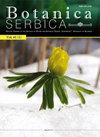激发子提高了双头金丝桃茎部培养物中生物活性化合物的产生
IF 1.1
4区 生物学
Q4 PLANT SCIENCES
引用次数: 0
摘要
本研究采用LC-MS/MS方法研究了茉莉酸甲酯(MeJA)和茉莉酸甲酯(JA)(50、100和200 μ M)激发子对双头金丝桃(Hypericum amblysepalum)茎部培养物中15种酚类化合物生长和产生的影响。50 μ M茉莉酸和MeJA诱导的茎部生物量增加。然而,较高浓度的激发子对茎部培养物的生长有负面影响,同时导致次生代谢物含量增加。激发子MeJA(特别是200 μ M MeJA)在增加酚类化合物含量方面效果更好。MeJA (200 μ M)诱导的芽中芦丁(2.8倍)、黄芪苷(2.4倍)、原儿茶酸(2.4倍)、橙皮苷(2倍)、假金丝桃素(1.9倍)、绿原酸(1.4倍)和金丝桃素(1.9倍)含量最高。此外,ja200m诱导子使木犀草素(2倍)、槲皮素(1.9倍)、芹菜素(4倍)、芹菜素(2.9倍)和金丝桃苷(1.3倍)的含量增加。目前的研究表明,在ambysepalum茎部培养中,特定的次生植物代谢产物可以通过外源激发子调节,从而突出了它们作为制药工业非常有价值的原料来源的前景。本文章由计算机程序翻译,如有差异,请以英文原文为准。
Elicitors enhanced the production of bioactive compounds in shoot cultures of Hypericum amblysepalum
In this study, we examined the effects of elicitors MeJA (Methyl jasmonate) and JA (Jasmonic acid) (50, 100, and 200 ?M) on the growth and production of 15 phenolic compounds in shoot cultures of Hypericum amblysepalum using the LC-MS/MS method. The biomass production increased on shoots elicited with 50 ?M JA and MeJA. However, higher concentrations of these elicitors had a negative effect on the growth of the shoot cultures, while simultaneously resulting in an increase in the secondary metabolite content. The elicitor MeJA (especially 200 ?M MeJA) was more effective in terms of increasing the phenolic compound contents. The highest amounts of rutin (2.8 fold), astragalin (2.4 fold), protocatechuic acid (2.4 fold), hesperidin (2 fold), pseudohypericin (1.9 fold), chlorogenic acid (1.4 fold), and hypericin (1.9 fold) were obtained from the shoots elicited with MeJA (200 ?M). In addition, the application of elicitor JA 200 ?M increased the amount of luteolin (2 fold), quercitrin (1.9 fold), apigetrin (4 fold), apigenin (2.9 fold), and hyperoside (1.3 fold). The current study revealed that specific secondary plant metabolites can be regulated by exogenous elicitors in shoot cultures of H. ambysepalum, thus highlighting their promise as a very valuable source of raw materials for the pharmaceutical industry.
求助全文
通过发布文献求助,成功后即可免费获取论文全文。
去求助
来源期刊

Botanica Serbica
Agricultural and Biological Sciences-Plant Science
CiteScore
1.40
自引率
12.50%
发文量
17
审稿时长
34 weeks
期刊介绍:
Botanica Serbica publishes original research papers on all aspects of plant, fungal and microbial biology research including the disciplines of microbiology, mycology, lichenology, bryology, flora, vegetation, biogeography, systematics, taxonomy, plant biotechnology, plant cell biology, plant ecology, environmental plant biology, forestry, genomics, horticulture, limnology, metabolomics, molecular biology, proteomics, virology, plant conservation and protection, and wildlife and ecosystem management.
 求助内容:
求助内容: 应助结果提醒方式:
应助结果提醒方式:


